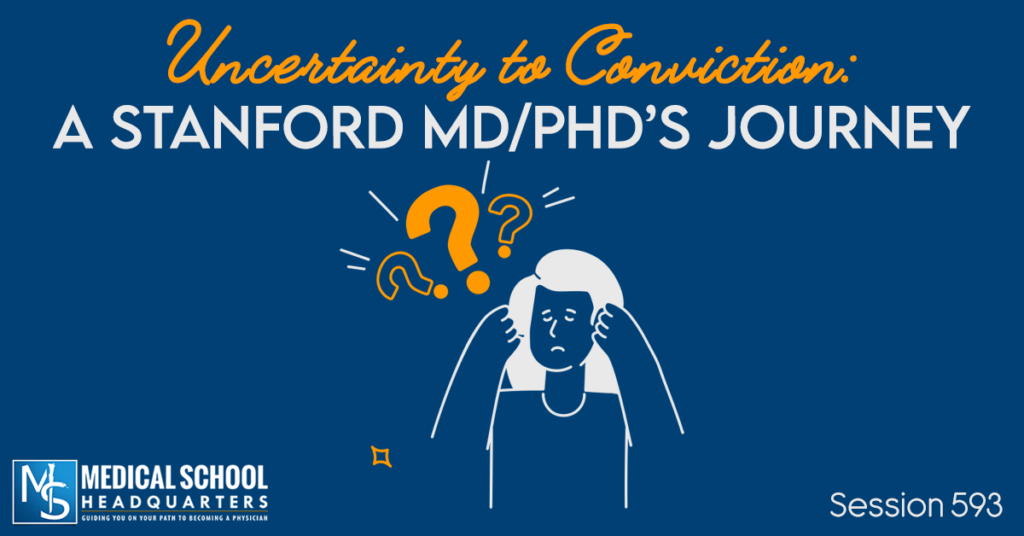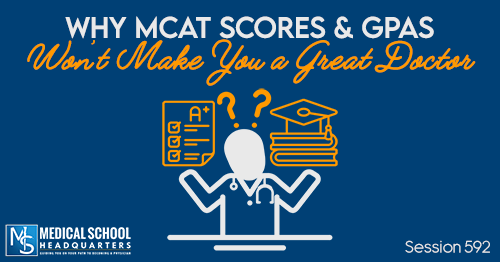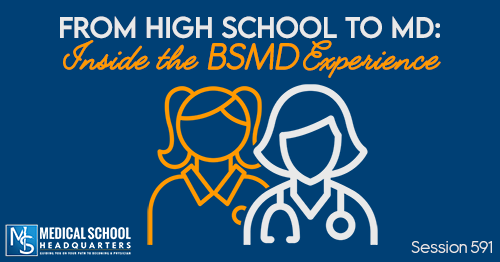If you’re taking the MCAT in the first few months of 2023, you might be making your study plan or already in the thick of MCAT prep. The MCAT is a long, difficult, and overwhelming test. Hopefully, this collection of our best tips and tricks can help you feel more confident and ready to crush the MCAT.
Here’s a summary of the steps involved in MCAT prep that I’ll cover in more detail in this article:
- Understanding the MCAT
- Know Your Baseline
- Content Review
- Practice Questions
- Full-Length Exams
- Deciding If You’re Ready
Understanding the MCAT
You first want to familiarize yourself with the MCAT process and the test’s basic structure. The AAMC publishes a guide to the MCAT that helps you understand the format, how your score is calculated, and how your score is used. It also includes 120 practice questions written by the test developers at the AAMC. For a brief overview, the MCAT is a 7.5 hour test covering General Chemistry, Biology, Organic Chemistry, Biochemistry, Physics, Psychology, Sociology, and Critical Reading Skills. The exam is offered in January, and March through September. The current registration fee is $330. This is waived for fee assistance program recipients, but if you plan to use fee assistance you need to apply before registering for the MCAT because the benefits aren’t retroactive.
Know What Your Starting Point Is
Your second step should be to understand where you’re starting from. Taking a diagnostic can give you a sense of your handle on the content covered. It also gives you a rough idea of how you would perform on the MCAT if you took it right now.
We recommend Blueprint’s free half-length diagnostic. You can take a diagnostic as soon as you know you need to take the MCAT. It’s most helpful when you’ve completed all or most of your prerequisites and have not yet started preparing for the MCAT.
In addition to letting you know how many points are between you and your goal score, a diagnostic test can help you understand your strengths and weaknesses. This will allow you to prioritize your time well and get the most out of your studying, like spending the most time on your weakest section or topic.
Content Review
What MCAT Books Should I Use?
Different students and different companies have their own favorite sets of books. Any set of MCAT books published after 2015 will serve you well if used properly. If the layout or structure of one series appeals to you over another, that’s as good a reason as any to choose that series. Many students in recent years seem to favor books from Kaplan or The Princeton Review.
The book set you buy also doesn’t need to be brand new. Finding a used set published after 2015 in decent condition can be an excellent way to save money on your prep materials. Your pre-health office or premeds at your school might sell their MCAT books after finishing the test.
Do I Need an MCAT Course?
MCAT prep courses can be an excellent option for many students, but they’re not a requirement. Different course structures will suit different types of students. Before purchasing a course, do your research to make sure you get the most out of your prep course.
Personalized tutoring may be the best option for students who have specific topics they need help with or one specific section they struggle with. A student wanting help with the test as a whole or access to other students to study with might be a better fit for a group class. You can find a variety of courses, from synchronous to asynchronous, and from in-person to virtual, from any of the major test prep companies.
If you tend to do well on standardized tests and are generally well-disciplined, you’re a good candidate for self-studying. If you’ve been out of the classroom for a long time, have historically struggled with standardized tests, or want external structure, you might be well suited to a formal MCAT course.
How Long Should I Prep?
There are so many factors that go into deciding how long to spend studying for the MCAT. You want to give yourself enough time that you’re well prepared, but you don’t want to spend so long in the depths of MCAT world that you burn out. Studying for anywhere from 3 to 6 months is fairly typical. A student who can study for the MCAT close to full time, with that being the main focus of their day, will lean toward the shorter end of things. You may need more time if you are also balancing school, work, or life. Everyone’s different.
Practice, Practice, Practice
Practice questions are the best way to study for any test, and the MCAT is no different. This is especially true for the MCAT, a test of not just content but also critical thinking and reading skills. Your reading skills and test-taking strategy can be honed through practice questions, increasing your MCAT score.
Some students wait to practice until they feel ready to start taking full-length practice exams. The problem with that is that it doesn’t give you enough time to practice before Test Day, nor enough time to build up your testing stamina.
Start Small and Grow From There
When you start incorporating practice questions into your MCAT prep, start with untimed practice passages. This will allow you to evaluate your grasp of the content without the pressure of the timer. Next, begin practicing timed passages, then move onto timed sections, before adding timed full lengths to your study schedule.
Once you’ve started taking full-length practice exams, you’ll still find it useful to practice passages and test sections. Discrete practice questions can also be useful for evaluating your knowledge of a more specific topic. The bulk of your practice should still be spent on passage-based questions since that makes up the vast majority of questions on the MCAT. You can access question banks through the AAMC’s MCAT prep materials, through a test prep company, or through other 3rd parties like UWorld. The AAMC materials will be the most representative of what you can expect to see on Test Day. You can use reviews and differing price points to decide which 3rd party question bank is the best fit for you.
All About Full-Lengths
When to Take Them
Even if you progress from passages, to sections, to full lengths, you might not feel quite ready when it comes time to take your first practice full length. And that’s okay. You won’t even feel completely ready when it’s time to take the actual MCAT. Having numbers to evaluate your progress will give you a much better sense of how your studying is going than how you feel about it.
How Many Full-Lengths Should You Take?
You want to take enough full-length practice tests that you can begin to get a sense of what your average score is. Each test is a little bit different and you’re a little bit different on each day as well. Because of this, you want to have a sense of what an average day, a bad day, and a good day looks like for you.
The AAMC has thus far published 4 scored full-length practice tests and we recommend you take all of them. We also recommend you save these for the last few weeks before your MCAT date. Since you want to save your official practice tests until the end of your study period, you’ll want to buy another handful of other practice tests. Your study books might come with them if you buy a new set, or they come with any typical prep course. A good amount of full-lengths is somewhere around 8. You might take fewer than this in order to give each one the time it takes to get the most out of your practice tests.
Why and How to Use Full-Lengths
Full lengths serve a few purposes. One of these is to make you more familiar with the format and pacing of the MCAT, and the experience of taking it. You’ll likely be nervous on Test Day, no matter what. Taking enough practice tests will remove some of the anxiety and allow you to feel sure that you know what to expect. You’ll have already figured out what breakfast and drinks make you feel your best, which of the optional breaks to take, and what you’re going to wear on Test Day. Feeling calm and prepared will allow you to perform your best. Taking plenty of full lengths also helps you develop your test-taking stamina and increase your speed, ensuring you have enough time to think through each question.
Full lengths also allow you to evaluate your progress as you move through your study plan. This self-evaluation throughout the process is another reason that taking a diagnostic early on is so important. Comparing the score you started with to the score you have now will allow you to see if you’re improving. If you see that you’re making less progress in Chem/Phys than in Psych/Soc, for instance, you might want to give physics some extra attention during your next study session. This also allows you to base decisions about where to focus your energy in data, rather than on how you feel about a particular section.
Reviewing Full-Lengths Is Critical
After taking a full-length (the next day or a few days later), go through it question by question. You’ll want to have some way of taking notes on which questions you got wrong and why. This process will often take as long as the exam itself, so build in breaks. Really poring over your results and analyzing your strengths and weaknesses is where many students start to see real improvement. Be honest with yourself about why you got questions wrong. Do you have a gap in your content knowledge? Was it a math error? Did you not read the question stem carefully? Did you misread or not understand a diagram? These are all issues that can be fixed if you take the time to recognize and learn from them. These seemingly small mistakes can add up and fixing them can make a big difference in your score.
Also take the time to review what you got right. It’s good to see where your strengths are. It can help you feel more positive about your studying and progress. It will also let you catch times where maybe extra coverage of that content would have made you more confident about your answer, even if you did get it right.
Apple Podcasts | Google Podcasts
When Are You Ready?
You will never feel fully ready to take the MCAT. Even if all of your practice scores have been great, there will still be fear that you’re not ready. If your scores are consistent and near your goal score, or have reached a score you’re comfortable with, then you’re probably ready. If you have a lot of variability in your scores, you might be ready, as long as you’re okay with the risk that the score you get is at the lower end of your range. Wide variability in scores can sometimes point to a content gap or weakness in critical reading skills, so if you can find and address that, you should be well prepared for Test Day. Eventually, you have to decide that you’re comfortable enough with your progress to take the leap.
The Biggest MCAT Mistakes Students Make
Not Having a Study Schedule
There’s no one correct study schedule, but building one can give you a sense of how much time you’ll truly spend on prepping for the MCAT. It can also help you decide if your target date is realistic. If you don’t have a study schedule, it’s incredibly difficult to keep up with the pace you have in mind for yourself. Without a schedule, you might fall off track and need to reschedule your MCAT which can get expensive.
On days where you don’t feel like studying, already having a topic chosen can help take some of the decision fatigue off your shoulders and help you get started. Using a schedule also helps you make sure you build in enough time for all of your full-length exams and other practice questions. It can be hard to know how to make a schedule, but the Blueprint free MCAT study scheduler takes your test date, and how many hours per week you have to study, and gives you a study schedule. You can use it even if you’re self-studying or using another test prep company. The other great thing about this scheduling tool is that it forces you to choose days off, which is something many students forget to do. You might get sick, have finals, or have life come up. If you’ve accounted for these things ahead of time, they’re less likely to throw your schedule off when they come up.
Being Unrealistic About What You Have Time For
Some students taking the MCAT are able to focus on it full time. Others may be splitting their time between the MCAT, school, and application prep. If you have fewer hours in the week to devote to test prep, you’ll need to spend more months studying. If you’re following the ideal timeline (taking the MCAT in January or March), your test prep, will coincide with the time where you should be drafting your personal statement.
It’s essential to recognize whether you have the time and capacity to balance these things at once. And if you don’t, that’s okay. Delaying your application by a year may give you the breathing room needed to crush the MCAT and write a great personal statement. It’s better to take the time to do it right the first time.
Rachel’s Wisdom
Here’s some sage advice from Rachel Grubbs, our resident MCAT expert with over 20 years of experience.
The first thing I say to anyone asking me about MCAT prep is that there’s no one best way to prep. You have to do your research, shop around, and find what works for you.
Even if you don’t sign up for a formal class, study groups help. It might be you and a handful of people from your university. You might also find people in the Premed Hangout Facebook group, or on the premed forums. No one really gets how hard this test is but the people who are going through it. You can encourage each other and hold each other accountable. Teaching each other is also an excellent way to review material. We’re pack animals by nature; find your community.
Most people don’t add enough room for error and rest in their study schedule. Do you have cultural holidays or family events coming up? You’ll want to schedule around those. We learn best when we have the space to rest, and you want to build that time into your schedule.
This is hard work. You are good enough.
More Links and Resources
How to Manage Test Anxiety Before and During Your MCAT







